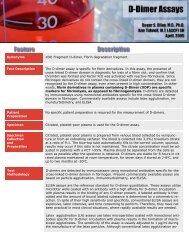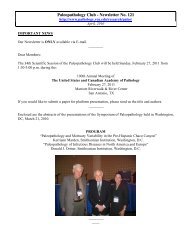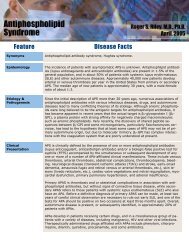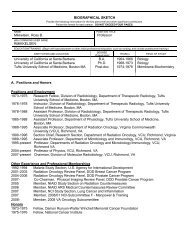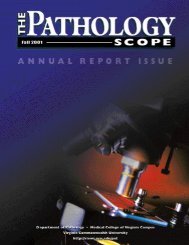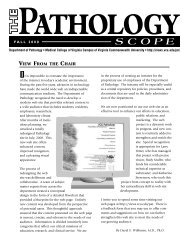Laboratory Monitoring of Warfarin Therapy - Pathology
Laboratory Monitoring of Warfarin Therapy - Pathology
Laboratory Monitoring of Warfarin Therapy - Pathology
Create successful ePaper yourself
Turn your PDF publications into a flip-book with our unique Google optimized e-Paper software.
<strong>Warfarin</strong> <strong>Monitoring</strong><br />
many environmental and dietary factors can<br />
change the dose-response. Measuring the<br />
prothrombin time (PT) remains the primary<br />
mechanism by which warfarin anticoagulation<br />
is monitored. Prolongation <strong>of</strong><br />
the PT, however, depends on the responsiveness<br />
<strong>of</strong> the thromboplastin used to initiate<br />
coagulation. Hence, the WHO has currently<br />
established and international standard by<br />
which manufacturers or individual labs can<br />
determine an international sensitivity index<br />
(ISI) for each lot <strong>of</strong> thromboplastin. A therapeutic<br />
range <strong>of</strong> PT is then defined by the international<br />
normalized ratio (INR), which is<br />
the ratio between the patients PT to the mean<br />
normal PT for the lab raised to the power <strong>of</strong><br />
the ISI:<br />
Fig. 2. A nomogram for obtaining<br />
an INR from a measured<br />
prothrombin ratio (i.e., ratio <strong>of</strong><br />
patient PT/mean normal PT). The<br />
ISI is provided by the manufacturer<br />
<strong>of</strong> each lot <strong>of</strong> prothrombin<br />
reagent (thromboplastin). In the<br />
example shown, an INR <strong>of</strong> 3.0 is<br />
obtained from a plasma sample<br />
with a PTR <strong>of</strong> 2.0 if the ISI is 1.6.<br />
INR = (Patient PT/Mean Normal PT) ISI<br />
where the “mean normal PT” is the geometric<br />
mean prothrombin time for the laboratory.<br />
The ISI is a correction factor, specific for each<br />
lot <strong>of</strong> laboratory prothrombin reagent, that<br />
correlates the activity <strong>of</strong> the reagent to a<br />
standard maintained by the World Health Organization.<br />
A smaller ISI reflects a more sensitive<br />
thromboplastin reagent such that a<br />
more prolonged PT will be observed for the<br />
same therapeutic effect.<br />
In most medical institutions, the INR is<br />
automatatically calculated by the laboratory<br />
information system. The INR can also be calculated<br />
from the above formula or derived<br />
from an INR nomogram (Fig. 2).<br />
The dosing <strong>of</strong> warfarin is driven by<br />
monitoring the prothrombin time to achieve<br />
a PT in the appropriate therapeutic range.<br />
Typically 5 to 10 mg <strong>of</strong> warfarin is administered<br />
daily with daily monitoring <strong>of</strong> the INR.<br />
The dose is changed gradually until therapeutic<br />
and then the INR is followed on a regular<br />
but less frequent basis. Adjustments in dosage<br />
should be based on the weekly dose since<br />
<strong>Warfarin</strong> <strong>Monitoring</strong> 4





